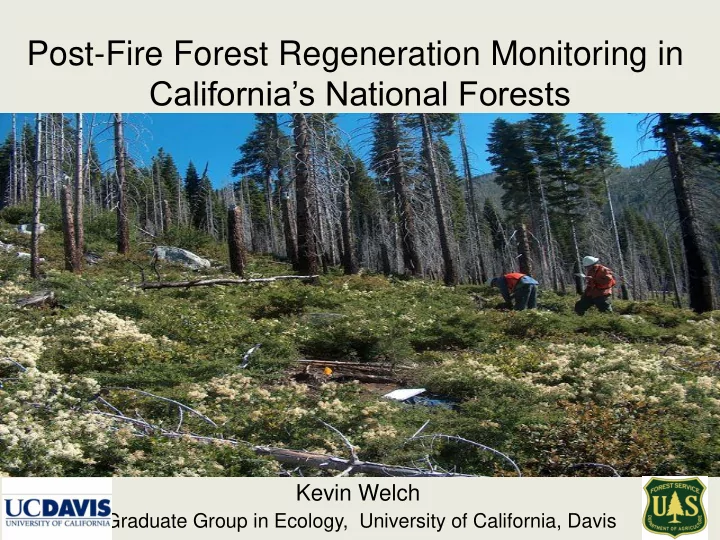

Post-Fire Forest Regeneration Monitoring in California’s National Forests Post-fire Forest Regeneration in the California ’ s National Forests Kevin Welch Graduate Group in Ecology, University of California, Davis
Wildfire on National Forest lands • Fire as disturbance regime (Sugihara et al. 2006, North et al. 2009 ) • Fire as a tool for ecological restoration, leading to spatial heterogeneity. In particular, low to mid-severity fires (PSW-GTR-220 2009) Increase in fire frequency & severity (Miller et al. 2009) What are the impacts of fire on forest recovery?
Regeneration in the Post-fire Environment • Quantify natural regeneration patterns in spatial detail across a wide variety of low- and mid- elevation fires of similar age • Monitor species-specific natural regeneration rates, accounting for differences in topography, fire intensity, and spatially explicit variables. • Provide these data to parameterize Forest Growth Simulator models. • Understanding regeneration is critical to effectively applying scarce restoration funds
My Research Questions I. What factors are driving regeneration patterns? What is limiting tree seedling abundancies across a range of fire severities? II. Do conifers respond differently than hardwoods to fire disturbance? Do conifers have a numerical advantage over hardwoods in the early stages of revegetation in the post-fire environment? Future question: III. To what extent is regeneration dependent on interannual climate variation? And how might these year effects be mitigated through time?
• Each Bassetts Fire (2006) LANDSAT pixel Tahoe National Forest is assigned a fire severity class, using the relative dNBR ( Miller & Thode, 2007) • mixed conifer/hardwo od forests; 200m grid is overlayed to represent a 10- acre sample point (660 ft interval, and 4 ha sample)
Bassetts Fire (2006) Fire total # of Severity plots 0 22 1 14 2 14 3 15 4 21 5 42
2009-10 Field Seasons 2011 Field Season �
Table 1: Sampled Fires Fire National Forest Year acres Year Plots burned sampled installed Deep Sequoia 2004 3,164 2009 24 Fre d’s El Dorado 2004 7,471 2009 121 Power El Dorado 2004 16,979 2009 155 Straylor Lassen 2004 3,333 2009 62 Showers Lake Tahoe Basin 2002 325 2009 17 Spanish Mendocino 2003 6313 2010 145 Shasta-Trinity & Six 2010 Sims Rivers 2004 3901 88 Pendola Tahoe & Plumas 1999 12,295 2010-11 180 Harding Tahoe 2005 2291 2010 67 Bar Shasta-Trinity 2006 101,652 2011 90 Bassetts Tahoe 2006 2,600 2011 128 Ralston Tahoe & El Dorado 2006 8,593 2011 94 Total: 168,917 1,171 Other fires: Showers Fire, Story Fire, Cedar Fire, Angora, and Rich Fire
Hardwood Seedlings resprouts Quercus . . . . Abies Pinus . Competition/interaction with shrubs • Ceanothus • Ribes • Arctostaphylos • Chamaebatia
Natural Regeneration by Species What does it look like when combined into one natural regeneration rate?
Natural Regeneration Rates * - What is responsible for this shape?
Pendola Natural Regeneration: 11-12 years after the fire, TNF & PNF 2 0 1 3 4 5 1 fire severity class
Natural Regeneration (seedlings/acre) Freds Fire Why this shape? Possible factors: -seed mortality -distance to potential seed tree - harsh conditions; lack of safe 0 1 2 3 4 5 microsites and fire severity class favorable micro- climatic conditions - competing/facilitating high shrub cover
Distance to Seed Tree Classification and regression trees revealed that in most fires, distance to potential seed tree was the F most influential predictor of regeneration i r
– – – Distance to Seed Tree Ralston Fire Figure 25: hardwood density Figure 24: conifer density (seedlings/acre) by distance to (seedlings/acre) by distance to con hardwd seed tree (ft) – Ralston Fire seed tree (ft) – Ralston Fire p=0.03 p=0.01
Effects of shrub cover on conifer seedling density Freds Fire Power Fire p = .02 P = .01 Competition for light, water, and nutrients
Interaction of shrubs with conifer heights & growth rates Conifer Height vs. Shrub Cover - Bar Fire Conifer Growth Rate vs. Shrub Cover - Bar Fire p=0.03 p=.02 depends on species and life history traits too
II. Natural Regeneration by Type and Resprouting Hardwoods note : hardwood resprouts are plotted against a 2 nd vertical axis (resprouts/acre).
Natural Regeneration by Type & Resprouting Hardwoods Power Fire Sims Fire fire severity class fire severity class
Conifers and Hardwoods 11-12 years after the Pendola Fire
Pendola: conifers and hardwoods 12 years after the fire p=.55 p=.01 Future analysis includes comparing covers
Mean Maximum Heights (ft) of Woody Vegetation Ralston Fire Competition for light and water resources
Conclusions • Fires show a generally unimodal relationship between fire severity and natural regeneration rates, with a peak in low severity class 2 and consistently declining to class 5 • Distance to potential seed tree an important factor in driving regeneration patterns • Conifers are outcompeting hardwoods through seedling production in the first 5-7 years. Does this change through time with the competition of hardwood resprouts? • In some fires, shrub cover negatively affected conifer seedling density • Timing of burn, year effects, and conditions in consequent years are all important factors
Future Potential Uses of Data • Provide spatially-explicit, species-specific regeneration trends and models • Permanent plot networks for future monitoring (long term succession, climate change effects) • Evaluation of effects of postfire management practices • Facilitate decisions about restoration activities • Where to replant; shrub and understory thinning? • Where will natural regeneration do the work? • Information sharing among forest districts.
Acknowledgements We would like to thank the United States Forest Service for providing funding for this project, and in particular, Hugh Safford, Mike Landram and Joe Sherlock for their assistance in the background analysis. A special appreciation goes to Chris Carlson (Univ. of Montana) for his insight, wit and training. And, of course, none of these data would have been collected without the tenacious field crew: Bill Stewart, Gabrielle Bohlman, Bliss Lee, Taylor Farnum, Vicki Alla, Clark Richter, Marcel Safford, Chris Preston, and Tara Roth.
Recommend
More recommend